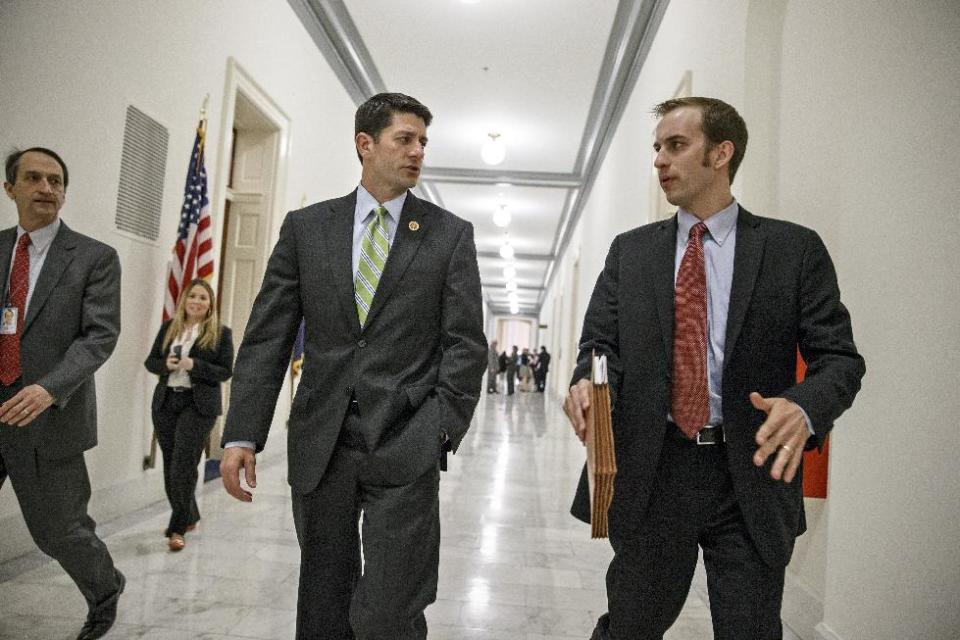House GOP plan seeks health cuts to balance budget
WASHINGTON (AP) — Republicans who control the House Budget Committee pressed ahead Wednesday on a budget-balancing plan that sharply cuts spending on transportation, health care programs for the middle class and the poor, food stamps and other domestic initiatives.
The plan by Rep. Paul Ryan, the committee chairman, promises $5.1 trillion in cuts to help bring the government's ledger into the black by 2024. His approach leaves in place Medicare cuts and tax increases engineered by President Barack Obama to pay for the new health law, but repeals the law's benefits.
The budget legislation promises to serve more as an election-year political and policy statement by House Republicans than a realistic attempt to engage Obama and Democrats, who control the Senate, in any serious effort to further cut the deficit.
Congress uses a nonbinding measure known as a budget resolution to set out goals for future taxes, spending and deficits. Follow-up legislation usually is limited to one-year appropriations bills rather than more difficult measures to deal with the government's long-term financial challenges.
Ryan, R-Wis., is pushing wide-ranging cuts to programs such as food stamps and government-paid health care for the poor and working class. While that's a nonstarter with Obama, Ryan is pitching his plan as a party-defining document outlining where Republicans would take the nation if they return to power after November's elections.
But his plan could face resistance in the full House because it embraces higher spending for agency budgets in 2015, as negotiated between Ryan and the head of the Senate Budget Committee, Sen. Patty Murray, D-Wash., in December.
Sixty-two House Republicans opposed the Ryan-Murray deal, and many of them need to come around once the emerging plan by Ryan's committee reaches the House floor.
"It'll pass," promised Rep. Kevin McCarthy of California, the party's chief vote-counter.
Ryan said his plan "puts us on the path to pay off our debt. How do we do it? We stop spending money we don't have. We cut waste and make much-needed reforms."
Ryan's budget brings back a now-familiar list of spending cuts: $2.1 trillion over 10 years in health care subsidies and coverage under the Affordable Care Act, the health law's formal name; $732 billion in cuts to Medicaid and other health care programs; almost $1 trillion in cuts to other benefit programs like food stamps, Pell Grants and farm subsidies.
While repealing the health law's benefits, Ryan would preserve its tax increases and cuts to providers, including reductions to private insurers under the Medicare Advantage program. Republicans have attacked Democrats for the Medicare cuts used to finance the health law.
"They repeal all the benefits of the law — like the tax credits that make insurance more affordable and the provisions that allow younger people to stay on their parents policies until age 26 — but Republicans keep all the ... budget savings. So do not try to fool the American people," said Maryland Rep. Chris Van Hollen, the top Democrat on the House Budget Committee.
The measure also reprises a proposal to dramatically reshape Medicare for future retirees, providing those who now are 55 or younger with a federal subsidy to buy health insurance on the open market.
Republicans say that makes Medicare sustainable with savings created by lower annual cost increases than traditional Medicare. Critics cite studies that predict the voucher-like plan would mean considerably higher out-of-pocket costs as it is phased in.
As in the past, Ryan has steered clear of cuts to Social Security, and he promises steady increases for veterans and restoration of looming defense cuts.
But he faces a more challenging task in balancing the budget by decade's end than he did last year because the Congressional Budget Office projects lagging revenues.
Steep cuts to Medicaid, which Ryan proposes to turn into a block grant program managed by the states, could drive millions of people from the program, including those in nursing homes and children from low-income households.

 Yahoo News
Yahoo News 

